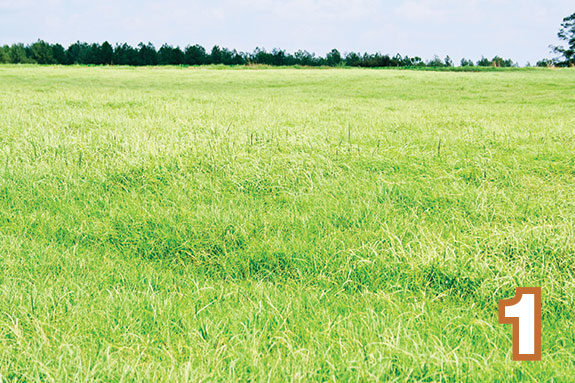The bermudagrass stem maggot (BSM) has become a pest for cattlemen and hay producers across the Southeast.
If your bermudagrass pasture or hayfield has a frosted appearance (Figure 1) in the middle of summer, it may have been damaged by this new invasive pest.
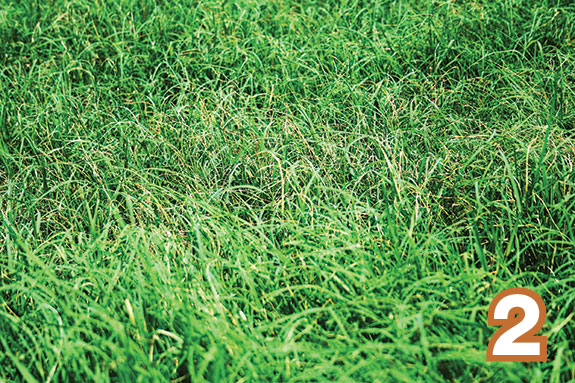
The damage is caused by the feeding of the immature stage of a fly, which is called a larva or a maggot.
Only the top parts of the shoots are damaged (Figure 2), while the lower leaves on the shoot remain green (Figure 3).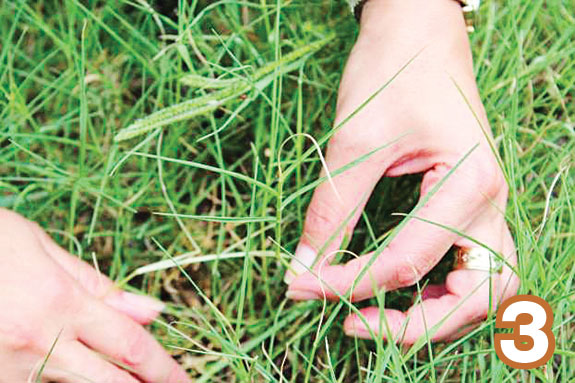
About the insect
Bermudagrass stem maggot (Atherigona reversura) is only a problem in bermudagrass in the U.S.
The insect has a few more grass hosts in other parts of the world.
It is native to south Asia from Japan westward to Pakistan and Oman.
Somehow it made its way to the continental U.S., where it was first found in Pierce, Jeff Davis and Tift counties in Georgia in 2010.
By the end of 2012, it was found throughout most of the Southeast.
The insect has also been accidentally introduced into Hawaii.
It is not unusual for new species to show up in North America. Unfortunately, in this case, there is very little information about this insect, its life cycle, the damage it causes or control measures for the insect.
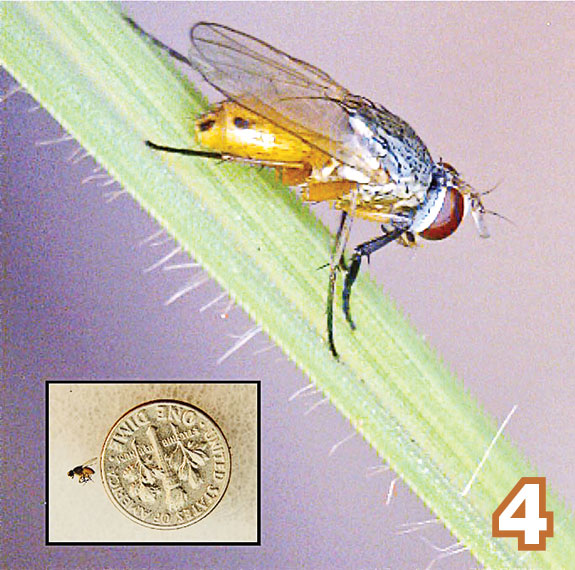
This article summarizes what scientists at the University of Georgia have learned about the pest in the past few years.
The fly is small and yellow-colored with dark eyes (Figure 4). The fly lays its eggs on the bermudagrass stem near a node.
The maggot is yellowish in color and grows to be about ⅛-inch long (Figure 5).
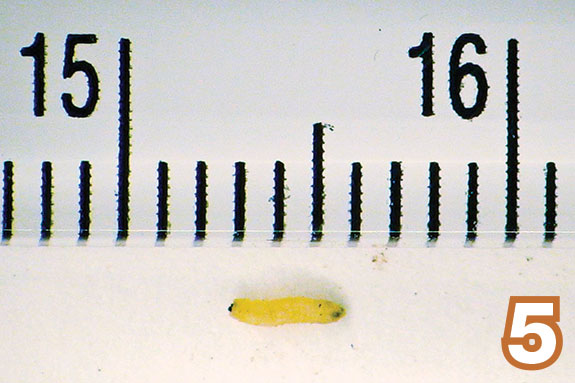
It may be hard to find the maggots because they have usually left the stem by the time the plant shows symptoms of damage.
There are multiple generations each summer. The fly has a life cycle that usually lasts about three weeks but can be as short as 12 days.
Mechanism of damage and economic impact
Upon hatching from the egg, the maggot (larva) works its way toward a node, where the leaf blade emerges from the stem.
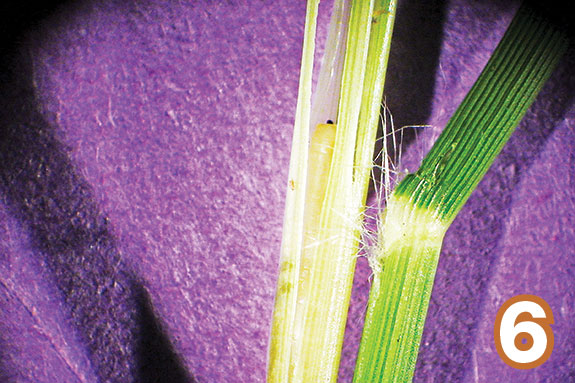
As the maggot develops, it burrows in the shoot and feeds (Figures 6 and 7).
The leaves (usually the top two) above the feeding site wither and die, resulting in potential yield loss.
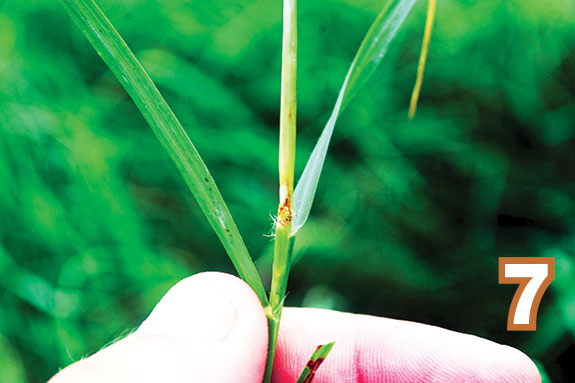
The death of these upper leaves while the lower leaves remain green causes the frosted appearance.
The shoot stops elongating as a result of the insect’s feeding.
In response to the damage, the plant may grow another shoot from a lower node of the damaged shoot (Figure 8).
The tip of the new shoot can also be attacked by later generations of the bermudagrass stem maggot.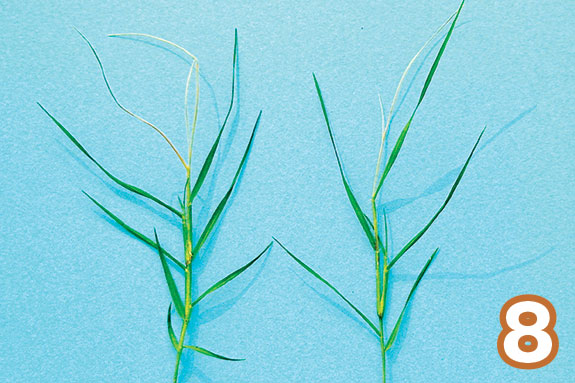
The amount of damage seems to depend on the point during regrowth when the flies lay their eggs.
In instances where good soil and moisture conditions allow a normal, rapid growth rate, the loss of the last one to three leaves seems to have a minimal impact on yield.
However, bermudagrass stem maggot damage may result in yield loss in growth periods limited by poor soil and moisture conditions.
In those situations, it is believed that the slow growth rate allows the egg-laying and larvae-development stages to occur relatively early in the grass growth cycle.
In many parts of the Southeast, infestations have increased to levels that cause some loss of yield – although the actual amount of loss varies considerably with cultivar and market.
Even though the fly damages only the top two leaves of the plant, the unsightly appearance may cause some buyers, especially those in the horse market, to reject the hay.
With heavy infestations, regrowth after a cutting can be slowed considerably.
Damage is worse in finer-stemmed cultivars like Alicia, Coastal, Russell and common bermuda. Damage almost never reaches economically important levels in coarser varieties like Tifton-85, even though these varieties are still attacked. Grazed pastures are not affected by the fly.
Management strategies
Harvest management is an option for mitigating the damage caused by bermudagrass stem maggot. If damage is found within one week of the normal harvest stage, proceed to harvest the crop as soon as weather conditions allow.
Once the damage becomes apparent, the crop is unlikely to add a significant amount of yield. If damage is observed within one to three weeks after the previous harvest, it is also likely that the crop will not add a significant amount of yield.
The damaged crop should be cut and (if the yields are substantial enough to warrant) baled and removed from the field as soon as weather conditions allow.
Leaving the damaged crop in the field will only compete with any attempts by the plant to regrow and decrease the opportunity that the next cutting will have to accumulate mass.
Control of bermudagrass stem maggot can also be achieved through the foliar application of relatively inexpensive insecticides.
Current recommendations are to treat after a cutting if damage levels are high. Best results have come from treating twice, once a few days after baling the previous crop as the grass begins to resprout and again five to seven days later.
The lowest labeled rate of any pyrethroid* insecticide approved for hayfield application has been effective. No differences have been noted among the brands or active ingredients.
There is no residual activity with these insecticides beyond a few days after application, but the infestation levels that cause concern usually build later in the season.
So far, a single round of treatments has lasted through the rest of the growing season. Considerable reduction in damage can be seen after a single application as the grass regrows, and for late season, that may be a more cost-effective option.
* Pyrethroid insecticides are those with active ingredients that end in -thrin, including beta-cyfluthrin, cyfluthrin, lambda-cyhalothrin and zeta-cypermethrin. Many brand names are available as these materials are off patent and offered by many marketers.
Henry Dorough is with the Alabama Cooperative Extension System.
—Excerpts from Alabama Extension Pest Management Series fact sheet
Editor's note: Click here to watch a video with Dr. Hancock for more information about this pest problem.
